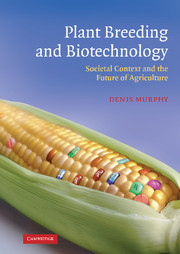Book contents
- Frontmatter
- Contents
- Preface
- Acknowledgements
- Using this book
- Nomenclature and terminology
- Abbreviations and glossary
- Introduction
- Part I The science of plant breeding
- Part II The societal context of plant breeding
- Part III Turmoil and transition: the legacy of the 1980s
- Part IV The agbiotech paradigm
- 11 Agbiotech: genes and dreams
- 12 The future of transgenic crops I: improving the technology
- 13 The future of transgenic crops II: improving the products
- Part V Increasing global crop production: the new challenges
- Part VI Plant breeding in the twenty-first century
- Notes
- References
- Index
12 - The future of transgenic crops I: improving the technology
Published online by Cambridge University Press: 07 May 2010
- Frontmatter
- Contents
- Preface
- Acknowledgements
- Using this book
- Nomenclature and terminology
- Abbreviations and glossary
- Introduction
- Part I The science of plant breeding
- Part II The societal context of plant breeding
- Part III Turmoil and transition: the legacy of the 1980s
- Part IV The agbiotech paradigm
- 11 Agbiotech: genes and dreams
- 12 The future of transgenic crops I: improving the technology
- 13 The future of transgenic crops II: improving the products
- Part V Increasing global crop production: the new challenges
- Part VI Plant breeding in the twenty-first century
- Notes
- References
- Index
Summary
Become addicted to constant and never-ending self-improvement
Anthony J D'Angelo (1997) The College Blue BookIntroduction
Transgenic crops will almost certainly have a viable future, providing they deliver what is really desired by farmers and consumers. It is useful to remember that the only benefits that any new crop varieties ever deliver in plant breeding terms are agronomically useful traits. If the same traits can be delivered by other, more accessible, breeding technologies, especially at lower cost and with less regulatory encumbrance, then, all things being equal, transgenesis may not necessarily be the favoured route. For example, during the Green Revolution, semi-dwarf crop traits were developed in the absence of transgenesis. Now that we know the identity of the genes involved in these traits, we could in future use transgenesis to create semi-dwarf varieties of other crops, including many of the orphan crops in Africa. Indeed, Japanese breeders have recently identified a new set of semi-dwarf traits in rice, plus the corresponding genes, and the use of these genes in transgenic varieties could result in a doubling of yields in the crop. However, even in this case, it is not absolutely necessary to use transgenesis to modify these genes. Because the position and nature of the genes are known, molecular markers have been developed that will enable breeders to select mutants carrying the desired semi-dwarf phenotype. In this case, a company or pubic sector breeder could, in principle, choose between transgenic and non-transgenic methods.
- Type
- Chapter
- Information
- Plant Breeding and BiotechnologySocietal Context and the Future of Agriculture, pp. 178 - 188Publisher: Cambridge University PressPrint publication year: 2007



